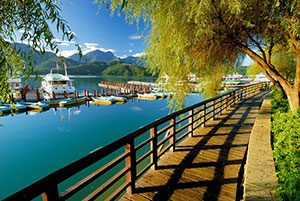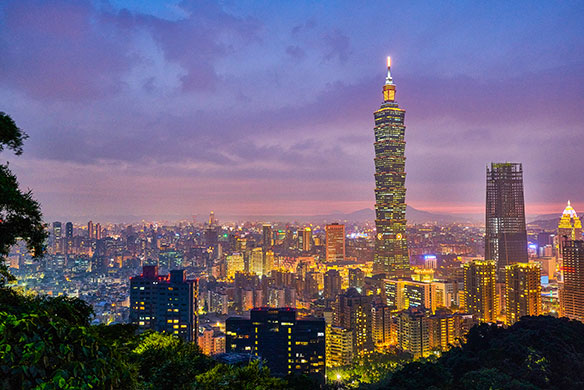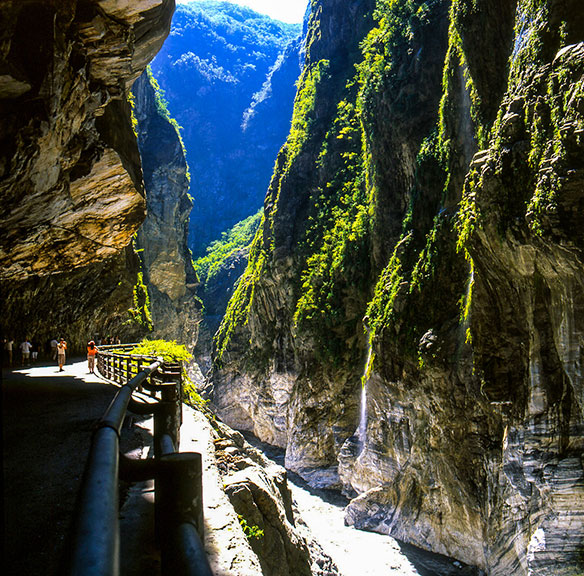
Tidal Changes
Eco and cultural tourism grows in Taiwan.
Ted Davis
(Pictured above: The Taipei 101 tower dominates the skyline of the city at night. It is 508 metres high and was once the world’s tallest building.
Photo: ©Taiwan Tourism Bureau)
For many travellers, Taiwan is largely defined by the retail/culinary attractions of the capital city, Taipei, with its busy, cosmopolitan environs. And, while that outlook is entirely valid, it fails to encompass the many other cultural and nature-borne aspects of this island at the top of the South China Sea.
Taiwan tourism authorities are increasingly emphasizing the charms of Taiwan outside the city limits of Taipei, and many tour options are available that demonstrate that. Near to Taipei, for example, is the popular village of Jiufen, which offers easy transport convenience from Taipei. The roughly 60-minute drive takes place on a multi-lane highway that narrows down to two lanes, as the road rises and curves around the bulk of Keelung mountain.
Then, around a bend, are the first glimpses of Jiufen, which clings to the hillsides in a precarious jumble of buildings. The more vertical orientation of the town defines its most popular attraction, which is the Jiufen Old Street.
This narrow, covered laneway is surfaced with stone and bordered with tiny, enticing shops selling antiques, curios, souvenirs, and fragrant snacks, all crowded together on both sides. The Old Street twists and turns as it trickles down the hillside, and can keep visitors busy for hours with its myriad products and treats. It ultimately spills out from under the roof, and onto a steep, descending stairway that ends at the parking lots below.
But before leaving, a few well-positioned hillside cafés and restaurants lure visitors with the promise of an outside table with great views of the mountainous countryside. Stop at the Ah Mei tea house for a tea that is especially prepared according to traditional methods, plus pastry bites to cure hunger pangs.
Taroko Gorge
Visitors who want to go further afield are encouraged to book a train ticket for the short two-hour trip across the north end of the island to the east coast of Taiwan, to the small city of Hualien. This trip provides more scenic evidence that most of Taiwan is covered by rugged, mountainous geography. In fact, some 75% of the island is defined by a north-south corridor of mountains that stretches right to sea at some points on the east coast. In this central cordillera, a few of the mountains reach over 3,500 metres in height and can even be expected to get snow in season.
This geography can be a pleasant surprise to those whose impressions of the island have been shaped only by Taipei. That is especially the case with the Taroko Gorge, a signature natural attraction in Taiwan near to Hualien that draws a steady stream of tourists.
The Liwu River that shaped the gorge spills out into a delta on the coastline of the Pacific. A twisting road follows the edge of the gorge as it climbs into the interior of the island, become progressively steeper and more scenic.
Vehicles of all sorts eventually stop at a check point, where passengers disembark and collect safety helmets, presumably to protect against any rock falls. They then walk further on the road along the edge of the gorge to marvel at the sheer canyon walls and shoot photos. Their transport awaits at the end of this scenic stroll. With Pacific Ocean waves pounding the beaches just a short drive away, it is a spectacular way to start altering perceptions of Taiwan.

Sun Moon Lake is a scenic tourist favourite in the mountainous interior of Taiwan, located at an elevation of 748 metres above sea level. The closest population centre is Taichung City, on the west coast of Taiwan, from which caches, taxi and cars operate, but no trains. Photo: ©Taiwan Tourism Bureau
Surfing Beaches
Some of those beaches have proven ideal for surfing. Taiwan’s east coast faces the brunt of Pacific Ocean waves, and parts of that are perfect for providing the wave breaks that are sought after by surfers. This becomes more apparent during the typhoon season, which brings angry storms and towering waves to Taiwan from as early as June through to October.
That’s when pioneering surfers start to gather at the village of Jinzun Harbour, which is about a 40-minute drive from Taitung, the closest big town. Jinzun Harbour is a fishing village and has only basic services, including a few cafés and guesthouses.
But surfers seeking new horizons don’t seem to care. Jinzun Harbour has proven to be an ideal location for the formation of waves that provide challenging rides for surfing, especially during typhoon season. It has served as the host location for an international surfing competition on the World Surf League circuit. Competitors say the swells created by the typhoons generate world class-surf waves at this otherwise quiet beach village.
History, culture in the city
After all that activity, more cerebral pursuits await back in Taipei. During the day, visitors will be occupied exploring a city that is buzzing with youthful energy and a leading-edge sense of architecture and fashion style. But they will also likely end up exploring the country’s past at the famous National Palace Museum, where they will see exquisite artifacts that originate from mainland China.
It houses about 700,000 artworks from ancient Imperial China, ranging from porcelains and jades to paintings and calligraphies, covering 8,000 years of Chinese art history.
Just one example is the collection of “pure and lustrous” porcelains that have been assembled from the period of Emperor Chengzu, the third ruler of the Ming dynasty, who took Yongle as his reign name.
During the twenty-two years of the Yongle reign (1403-1424), the Ming dynasty witnessed major cultural and military advances. Projects that were sponsored by the Yongle emperor include the construction for the Forbidden City in Beijing and the production of numerous imperial wares, including the fine porcelains. Six centuries later, many of these porcelain treasures still survive and are on display at the National Palace Museum.
Nightlife in Taipei will be a key attraction for customers who are seeking urban dining and entertainment activities extending to midnight and beyond.
That’s standard procedure in Taipei, with more traditional high-end restaurants closing at 11:00, but with plenty more eateries and night markets open for hours longer after that, says Esther Lin, general manager of Super Value Tours in Burnaby, BC. “Some places are open all night,” said Lin. “People in Taipei don’t go to sleep until 1:00. The Taiwanese don’t waste a minute of time!”
China Airlines brings A350 luxuries to Vancouver
Now adding a new element of luxury to flights between Vancouver and Taipei, Taiwan, is the new Airbus A350 aircraft that has been introduced by China Airlines on the route.
The aircraft is configured for 306 seats over three cabin classes. These are Premium Business with 32 seats, Premium Economy with 31 seats, and Economy with 243 seats.
An ambience rooted in Oriental aesthetics has been enhanced by youthful style elements throughout the aircraft. Also helping to welcome passengers is cabin mood lighting that simulates natural surroundings to make the trip more restful.
China Airlines introduced the Airbus A350 on the Taipei-Vancouver route as of August this year.
The latest addition means that all North American destinations, including Los Angeles, New York and San Francisco, are now being flown by new B777 or A350 aircraft.
This is a new milestone for China Airlines.
(www.china-airlines.com/tw/en)
(Photo below: ©Taiwan Tourism Bureau)


